![How To Make/Create an Invitation in Google Docs [Templates + Examples]](https://images.template.net/wp-content/uploads/2023/07/How-To-Make_Create-an-Invitation-in-Google-Docs-Templates-Examples-788x443.png)
How To Make/Create an Invitation in Google Docs [Templates + Examples]
To formally invite someone or a group of people to an event or activity, you will need to send out…
Sep 02, 2025
Dashboards present information graphically with an easy-to-navigate user interface and a streamlined data visualization design. For this interactive board overview to house enough data space on one screen and make sure the important underlying data are strategically configured in the dashboard, it helps to start observing the appropriate dashboard sizes first.
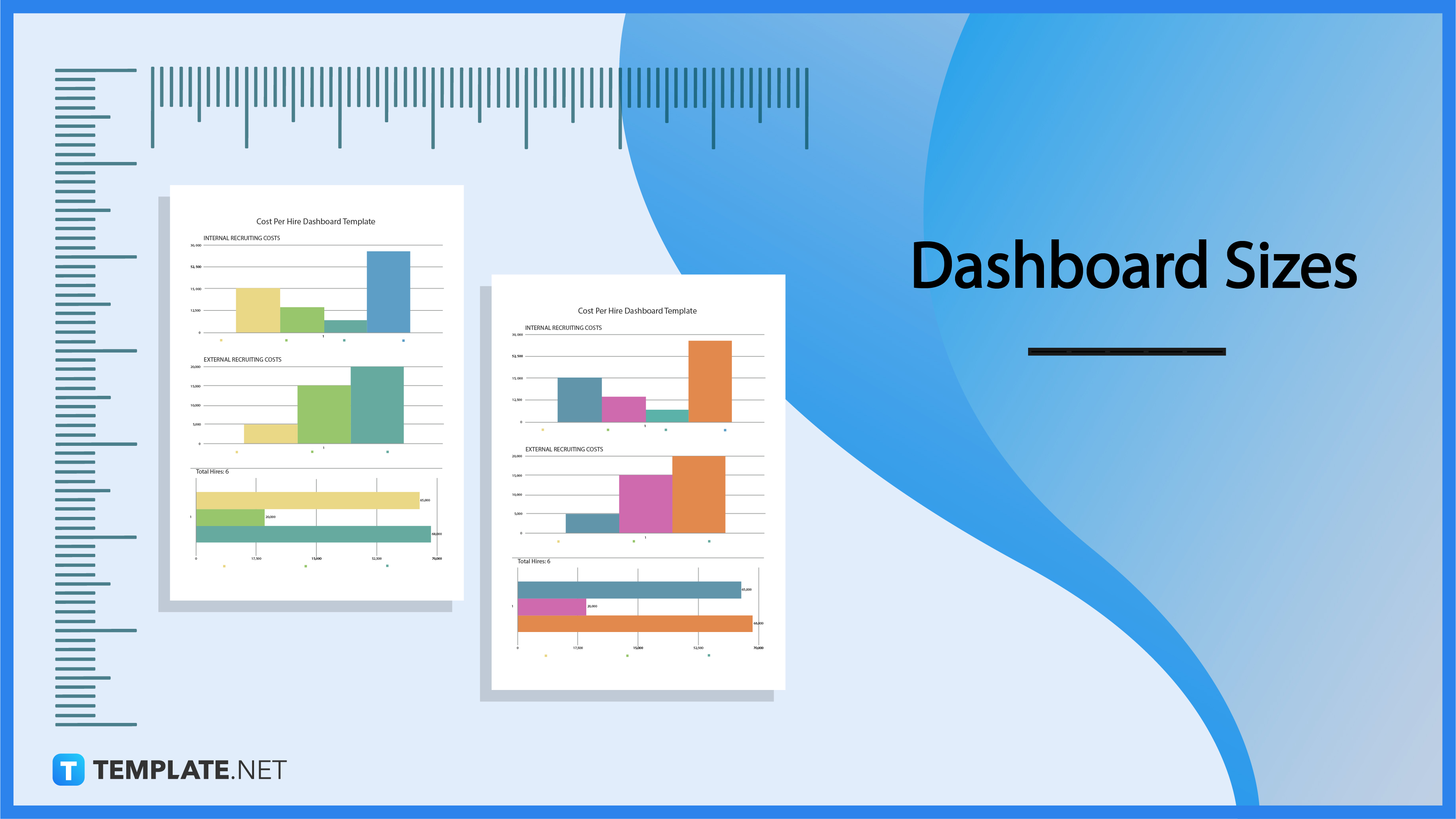
Dashboard sizes refer to the layout dimensions and resolution settings used in designing data dashboards for optimal visualization and usability. Common sizes vary depending on screen type—desktop, tablet, or mobile—with 1280×720 and 1920×1080 pixels being popular choices. Choosing the right dashboard size ensures data is presented clearly without clutter, improving user interaction and decision-making. Proper sizing also enhances responsiveness, accessibility, and overall performance across different devices and display environments.

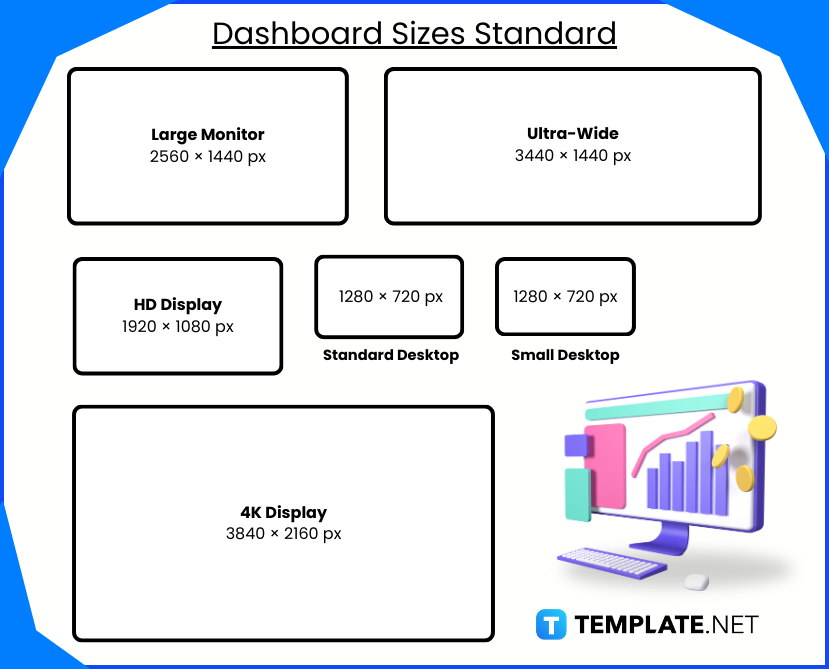
| Screen Size | Dimensions (px) | Aspect Ratio | Notes |
|---|---|---|---|
| Small Desktop | 1280 × 720 | 16:9 | Minimum width for dashboard usability |
| Standard Desktop | 1366 × 768 | ~16:9 | Very common resolution |
| HD Display | 1920 × 1080 (Full HD) | 16:9 | Ideal for analytics dashboards |
| Large Monitor | 2560 × 1440 (QHD) | 16:9 | Great for data-heavy dashboards |
| Ultra-Wide | 3440 × 1440 | 21:9 | Used in trading or monitoring systems |
| 4K Display | 3840 × 2160 | 16:9 | Best for high-end detailed interfaces |
How much space a dashboard consumes on a single screen is measured according to the width and height, and different dashboard sizes are depending on which device or screen you access a dashboard. If you want to view a dashboard on a laptop, the minimum laptop-size dashboard is 800 × 600 px with an aspect ratio of 1.33:1 or 4:3.
If you are using a desktop computer or any monitor with high resolution to optimize a dashboard, opt for the desktop or computer-size dashboard in pixels. The dimensions that offer the best quality in this example are 1000 × 800 px (1.25:1).
Dashboards accessed with smaller screens such as in a mobile layout or simply a web-embedded dashboard don’t need to have big measurements as they might take a long time to load on your gadget or device. The 420 × 420 px (1:1) marks the minimum size accepted in web-embedded dashboards.
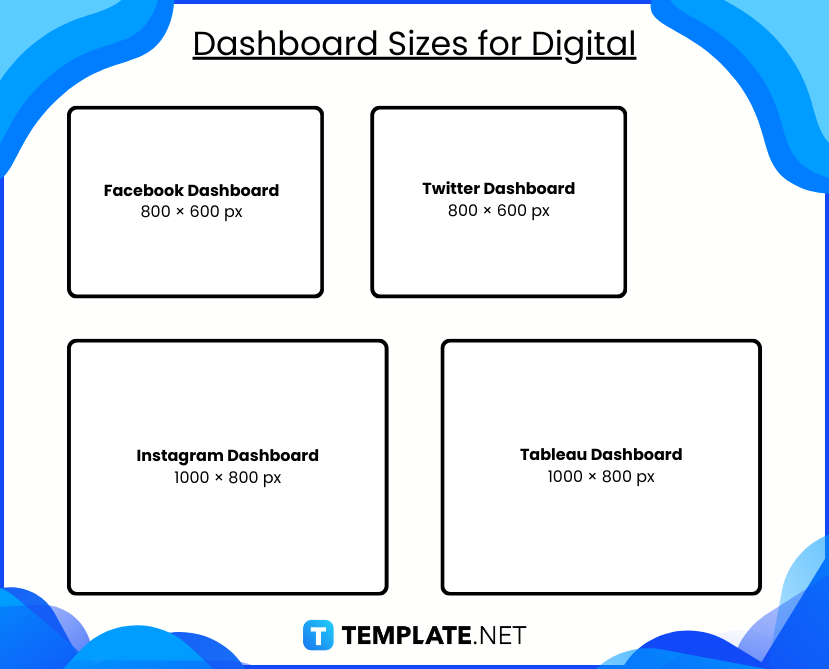
| Platform | Recommended Size (px) | Aspect Ratio | Notes |
|---|---|---|---|
| Facebook Dashboard | 800 × 600 to 1000 × 800 | 4:3 to 5:4 | Tracks page views, fan growth, post likes, ad performance, etc. |
| Instagram Dashboard | 1000 × 800 | 5:4 | Professional dashboard for creators to monitor insights and engagement |
| Twitter Dashboard | 800 × 600 to 1000 × 800 | 4:3 to 5:4 | Used via Twitter Analytics or TweetDeck for tweet performance analysis |
| Tableau Dashboard | 800 × 600, 1000 × 800, 420 × 420 | 4:3, 5:4, 1:1 | Offers flexible layouts: fixed, range, and automatic depending on screen/device |
Check and analyze the KPIs of your Facebook business profile page, ad, post, and more with the Facebook dashboard measured similarly to the standard dashboard sizes—depending on what device you’re using. Known as the biggest social media worldwide, leverage Facebook’s dashboard to stay updated on your top sources of page views, the total number of fans, the top countries of gained fans, the total number of post likes, etc.
Expect to view Instagram’s dashboard in the highest quality of 1000 × 800 px if you’re accessing the dashboard on a high-resolution screen. Called a Professional Dashboard, this specific IG dashboard is the very core where you access graph analysis, view a performance report, and many other professional systems for creators to stay wary of their profile insights.
Twitter Analytics and TweetDeck (pro dashboard tool) are the main data dashboards used to check your account’s performance on Twitter; examples include viewing your tweet activities, total followers, total impressions, total engagements, chart comparisons, and other metrics. From 1000 × 800 px to 800 × 600 px dashboard size, the dimensions of the dashboard would depend on what device or screen you are using.
The Tableau software is the very epitome of data visualization and it only makes sense it follows the three main dashboard sizes (800 × 600 px, 1000 × 800 px, and 420 × 420 px); however, you have to remember that layouts would vary according to the device you’re using the dashboard. Also, Tableau has a series of dashboard size options such as fixed size, range, and automatic while the layout orientations may either be in landscape or portrait.
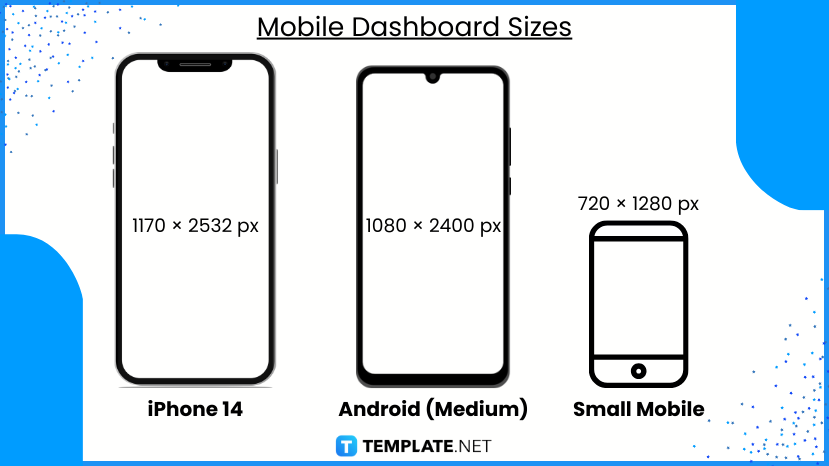
| Device Type | Screen Size (px) | Aspect Ratio | Notes |
|---|---|---|---|
| iPhone 14 | 1170 × 2532 | ~19.5:9 | Modern iOS dashboard screen |
| Android (Medium) | 1080 × 2400 | 20:9 | Common Android resolution |
| Small Mobile | 720 × 1280 | 16:9 | Min for mobile dashboard support |
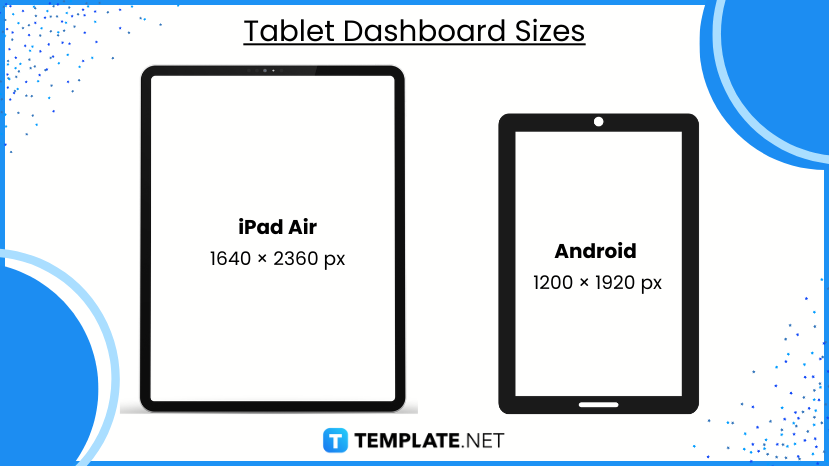
| Device | Screen Size (px) | Aspect Ratio | Notes |
|---|---|---|---|
| iPad Air | 1640 × 2360 | ~4:3 | Great for touch dashboards |
| Android Tablet | 1200 × 1920 | 16:10 | Responsive layout needed |
Most sites allow you to print dashboards by exporting the dashboard file as PDF and printing it as a document. While printing a dashboard’s content, measurements are now done in inches, centimeters, and millimeters such as the letter (8.5″ × 11″, 21.59cm × 27.94cm, or 215.9mm × 279.4mm), legal (8.5″ × 14″, 21.59cm × 35.56cm, or 216mm × 356mm), and A4 (8.3″ × 11.7″, 21.08cm × 29.72cm, or 210mm × 297mm) sizes. Don’t forget to set custom sizes according to whichever format, size, or orientation (landscape or portrait) fits best to a print copy of a dashboard.
Most users, who check the metrics, results, and KPIs in a dashboard, are concerned with business operations. Whether your business involves office tiles, community markets, school tutorials for students, text cards, dash banners, health model books, cameras, radio equipment, or interior furniture sales, configure the right elements to put into your dashboard. Business dashboard sizes still depend on what device you’re accessing the dashboard with, and the other average sizes per device are 1024 × 768 px (tablet/iPad/iPad Mini/HTC Nexus 9), 1280 × 800 px (Amazon Kindle Fire HD/Samsung Galaxy Tab 10), and 960 × 600 px (Google Nexus 7/Asus Nexus 7 v2).
You can create a rough draft of how your custom dashboard looks from the web design, format, layout, and data presentation using Adobe Photoshop’s plethora of tools. You can set your own KPIs or metrics, shape the priority levels of each graphic content, design a signature color scheme for the font, icons, widgets, and background, and more. Just make sure to mind the standard dashboard sizes while designing a dashboard design draft in Photoshop such as 1000 × 800 px—the default dashboard size on a desktop browser.
You can also excel in your dashboard design-making skills with Adobe Illustrator, especially when this option has many unique tools you can customize. Even in Illustrator, you have to adjust your dashboard sizes according to what fits a screen or device. It is acceptable to observe a dashboard in the default browser size (1000 × 800 px), laptop size (800 × 600 px), web-embedded size (420 × 420 px), fit-all size (automatically resize depending on the device model, type, and orientation), and fit-width size (automatic adjustment for mobile phone viewing).
A good dashboard size for optimum quality and standard browser viewing is 1000 × 800 px.
Know what set of relevant objectives and KPIs you want to input in a dashboard, look for a website to create your dashboard because the features and rules would vary, optimize a dashboard template so you won’t need to start from scratch and make sure the dashboard is easy to navigate or understand with the public.
Tableau suggests 800 × 600 px, 1000 × 800 px, and 420 × 420 px.
Fixed-size dashboards enable you to manipulate the specific position or area of every content in your dashboard—a must-have feature for dashboards with floating objects.
It means viewing the dashboard size adjusts to whichever screen, monitor, or device you are using.
A dashboard is valuable for precise metric records and detailed critical reports.
These data measures are called metrics, and they represent pieces of data in different criteria, dimensions, or measurement units.
Define the objectives or purpose of your proposed dashboard.
Yes, you can change the story dashboard size by not setting it as a fixed size.
Tableau recommends the floating layout as the best example for a dashboard.
Analyze the results and data displayed in a dashboard if the usage rate is high, the profit margin is high, or any other criteria that tell you what is successful or a failure from the dashboard’s metrics.
![How To Make/Create an Invitation in Google Docs [Templates + Examples]](https://images.template.net/wp-content/uploads/2023/07/How-To-Make_Create-an-Invitation-in-Google-Docs-Templates-Examples-788x443.png)
To formally invite someone or a group of people to an event or activity, you will need to send out…
![How To Create an ID Card in Google Docs [Template + Example]](https://images.template.net/wp-content/uploads/2023/07/How-To-Create-an-ID-Card-in-Google-Docs-Template-Example-788x443.png)
ID cards are used as a way to represent an individual to the company or organization they work or volunteer…
![How to Make an ID Card in Microsoft Word [Template + Example]](https://images.template.net/wp-content/uploads/2023/07/How-to-Make-an-ID-Card-in-Microsoft-Word-Template-Example-788x443.png)
ID cards are an essential part of any employee working for a company or an organization to be recognized as…
![How To Make/Create a Book Cover in Google Docs [Templates + Examples]](https://images.template.net/wp-content/uploads/2023/07/How-To-Create-a-Book-Cover-in-Google-Docs-788x443.png)
Aside from protecting a book, book covers are specifically designed to attract readers and convey the essence of the book.…
![How To Make/Create a Book Cover in Microsoft Word [Templates + Examples]](https://images.template.net/wp-content/uploads/2023/07/How-To-Create-a-Book-Cover-in-Microsoft-Word-788x443.png)
A book cover is the outer layer of a book that is used to protect its contents. Book covers are…

Job vacancy is a common scenario in companies and organizations. Employees leave for all kinds of reasons and when they…

Save the date sizes are usually the same size as a formal invitation. But there are a number of different…
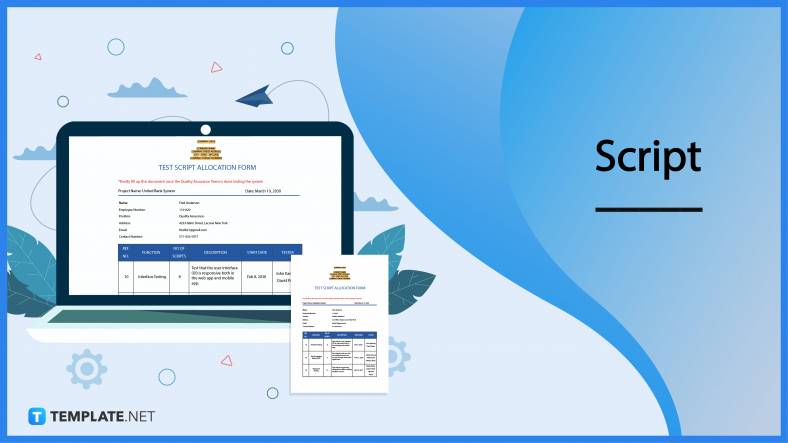
Script is a popular word that is frequently used in the entertainment world. There are a variety of areas and usages…

Presentations may not look as pleasant as how you design them with pictures, animations, videos, and other graphic designs without…